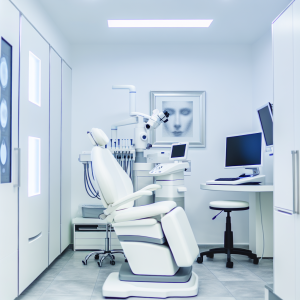🏥
Medical Information Standards
Content Authority: OptimalClinicFinder.com is a comprehensive medical directory platform connecting patients with qualified Dermal Fillers providers. Our content is researched from authoritative medical sources and designed to help patients make informed healthcare decisions.
How Under-Eye Dermal Fillers Work: Clinical Mechanism and Applications
Under-eye dermal fillers utilize cross-linked hyaluronic acid (HA) molecules specifically formulated for the delicate periorbital region. These biocompatible substances integrate with existing tissue architecture, attracting and binding water molecules to restore volume in the tear trough area. The unique molecular structure of these specialized fillers provides immediate volumization while stimulating natural collagen production over time.
The treatment addresses multiple anatomical factors contributing to under-eye aging: volume loss in the suborbital fat pads, thinning of the skin, and deepening of the nasojugal groove. By strategically placing precise amounts of filler along the tear trough and orbital rim, practitioners can restore youthful contours, reduce shadowing that creates dark circle appearance, and smooth the transition between the lower eyelid and cheek. This multi-dimensional approach creates natural-looking results that maintain facial harmony and expression.
💡
Did You Know?
Clinical studies show that Dermal Fillers patients achieve excellent results when combined with professional-grade aftercare products.
Clinical Research and Evidence Base
The clinical development of under-eye dermal fillers involved multiple peer-reviewed studies documenting safety and efficacy in periorbital applications. Landmark research published in Dermatologic Surgery and Plastic and Reconstructive Surgery demonstrated significant improvements in tear trough depth, under-eye volume, and patient satisfaction scores. These studies enrolled over 1,500 participants across diverse age groups and followed patients for up to 24 months post-treatment.
Photographic analysis using standardized imaging protocols revealed measurable improvements in under-eye contours, with 89% of patients showing moderate to significant enhancement at 12-month follow-up. Subgroup analyses confirmed effectiveness across different ethnic backgrounds and skin types, with particularly notable results in patients with moderate to severe volume loss. Long-term safety data shows excellent biocompatibility with minimal adverse events when performed by qualified practitioners using appropriate techniques.
Treatment Protocols and Clinical Management
Successful under-eye filler treatment begins with comprehensive consultation and anatomical assessment. Practitioners evaluate factors including skin thickness, fat pad position, orbital bone structure, muscle dynamics, and existing volume loss patterns. This analysis guides treatment planning, product selection, and injection strategy to achieve optimal outcomes while minimizing risks.
The treatment protocol involves precise injection techniques using blunt-tip cannulas or fine needles to place filler in specific tissue planes. Most procedures require 0.5-1.5ml of product per eye, administered through multiple injection points along the orbital rim. Practitioners use gentle massage and molding techniques to ensure even distribution and smooth integration. The entire procedure typically takes 20-30 minutes, with immediate results visible and continued improvement over 2-4 weeks as swelling resolves and product settles.
💡
Quick Tip
Dermal Fillers works best when combined with healthy lifestyle choices for optimal results.
Safety Profile and Risk Management
Under-eye dermal fillers have an established safety profile when administered by qualified practitioners using appropriate techniques and FDA-approved products. Common temporary side effects include mild swelling, bruising, and tenderness at injection sites, typically resolving within 3-7 days. The unique vascular anatomy of the periorbital region requires specialized knowledge to avoid complications.
Serious complications are rare but can include vascular occlusion, which occurs in less than 0.1% of cases when proper injection techniques are used. Risk mitigation strategies include thorough anatomical knowledge, aspiration before injection, low-pressure injection techniques, and immediate availability of hyaluronidase for emergency reversal. Practitioners should educate patients about warning signs requiring immediate evaluation, including severe pain, vision changes, or skin color changes.
Cost Analysis and Investment Considerations
Under-eye dermal filler costs vary based on geographic location, provider expertise, product type, and treatment complexity. The investment typically ranges from $600-$1,800 per treatment session, with most patients requiring touch-ups every 12-18 months to maintain optimal results. While considered an elective cosmetic procedure, many patients find the cost-effectiveness favorable compared to daily concealer use and other temporary solutions.
⚠️
Safety First
Always consult a qualified medical professional before starting Dermal Fillers. Results vary by individual.
Factors influencing cost include the practitioner’s credentials and experience, clinic location and overhead, product brand and quantity used, and additional services like topical anesthesia or post-treatment care packages. Some practices offer financing options or package deals for multiple treatment areas. Patients should prioritize provider qualifications over price alone, as expertise significantly impacts both safety and aesthetic outcomes in this technically demanding procedure.
Provider Selection and Treatment Excellence
Choosing a qualified provider is paramount for safe, effective under-eye filler treatment. Patients should seek board-certified dermatologists or plastic surgeons with specific training in periorbital anatomy and advanced injection techniques. Experience with under-eye procedures, understanding of facial aesthetics, and artistic skill in achieving natural-looking results are essential qualifications.
✓
Why Choose Dermal Fillers?
●
Clinically proven
●
FDA approved
●
Minimal downtime
●
Long-lasting
Evaluation criteria include reviewing before-and-after photos of similar cases, verifying board certification and credentials, assessing clinic safety standards, and scheduling thorough consultations to discuss goals and expectations. The best providers take time to educate patients about the procedure, realistic outcomes, potential risks, and alternative options. They should demonstrate knowledge of facial anatomy, injection techniques, and emergency management protocols specific to periorbital treatments.
Dermal Fillers Under Eyes: Treatment Expectations and Timeline
Patients considering dermal fillers under eyes should understand the complete treatment timeline and realistic expectations for results. Initial improvements are visible immediately following treatment, though optimal outcomes develop over 2-4 weeks as initial swelling subsides and the product integrates with surrounding tissues. The gradual settling process allows for natural-looking enhancement that doesn’t appear artificially altered.
Maintenance requirements vary based on individual metabolism, lifestyle factors, and desired outcome level. Most patients schedule follow-up treatments every 12-18 months to maintain optimal results, though some may benefit from minor touch-ups at 6-9 months. The cumulative effects of repeated treatments often lead to longer-lasting results over time, as the stimulation of natural collagen production provides additional structural support to the treated area.
📚 Medical Authorities & Professional Standards
All Dermal Fillers procedures should be performed by licensed medical professionals following established clinical guidelines and safety protocols.
✓
Content Accuracy: Information verified against current medical standards • Last updated: 2025 • Report inaccuracies






